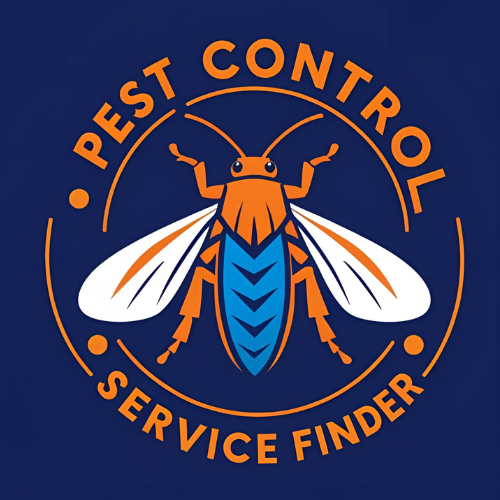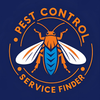do it yourself home insect control: Simple, Effective Tips
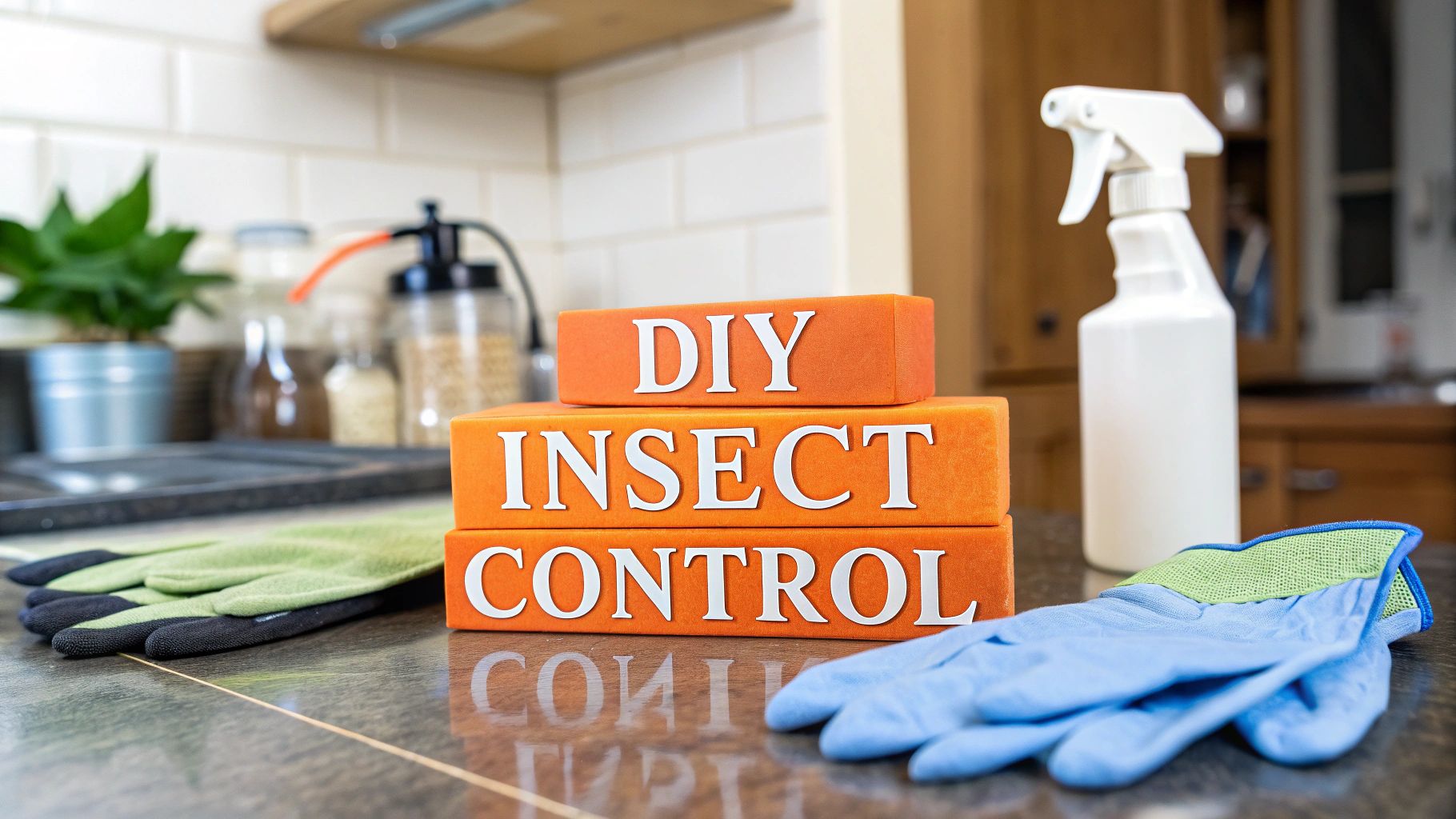
Think a bug spray is the answer? It's not. The best insect control is simple. It starts before you see a single bug. Your goal is a smarter game plan. It is about prevention. It is about understanding the pest.
Rethinking Your Approach to Home Insect Control

When most homeowners spot a bug, the first instinct is to go on the offensive with the strongest spray they can find. This "spray first, ask questions later" mentality usually just leads to frustration. Sure, you might kill the few bugs you see, but you haven't done a single thing to address the real problem. If you need help figuring out the real problem, a quick call to +1 855 224 3071 can connect you to an expert.
A much better way forward involves a complete shift in mindset. Instead of just reacting, you need to start thinking like a detective. The real secret to a pest-free home is figuring out exactly what insect you're dealing with, how it's getting inside, and what it's looking for. That’s the core of successful do it yourself home insect control.
The Foundation of a Smarter Strategy
This proactive method is what the pros call Integrated Pest Management (IPM). It's a common-sense approach that puts long-term prevention first, using targeted treatments only when absolutely necessary. You can dive deeper into the specifics in our guide on what Integrated Pest Management is and how you can apply it at home.
This smarter strategy really boils down to three key principles:
- Identification: Knowing you have carpenter ants instead of simple sugar ants changes your entire plan of attack.
- Exclusion: Finding and sealing the tiny cracks pests use as a highway into your house is far more powerful than any spray.
- Sanitation: Cutting off their access to food, water, and shelter makes your home a much less attractive place for insects to hang out.
Adopting this mindset won't just save you money on products that don't work. It also creates a much safer environment for your family and pets. For questions about applying these principles, you can always Call +1 855 224 3071 for advice.
The goal isn't just to kill pests; it's to create an environment where they can't thrive in the first place. This preventative focus is the most powerful tool in your DIY arsenal.
Safety First Especially with Pets
Part of this smarter approach means choosing your battles wisely, especially when it comes to pesticides. If you have pets, you have to be extra careful. Many common chemicals can be incredibly harmful to animals. Before you buy anything, do your homework. A great starting point is reading through a pet owner's guide to safe pesticides—it’s a responsible first step for any pet owner.
While these DIY methods are fantastic for managing common pests, some situations are just too big to handle alone. A widespread infestation or the discovery of destructive pests like termites often requires a professional. If you're feeling overwhelmed or the problem keeps getting worse, don't hesitate to call in the experts. You can get a fast consultation by calling +1 855 224 3071 today.
Identifying Common Household Pests
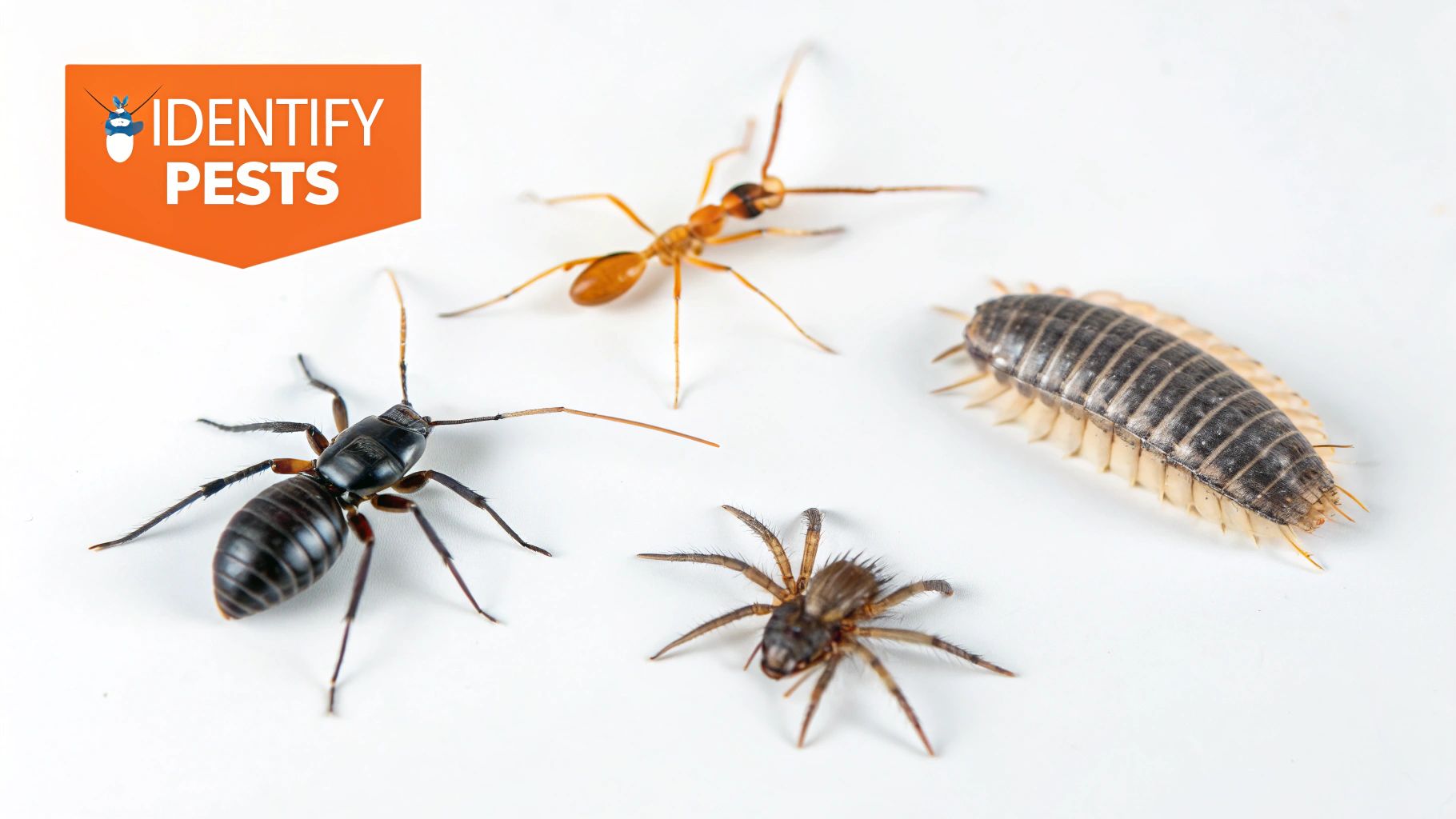
You can't win a battle if you don't know your enemy. That old saying is the absolute foundation of effective do it yourself home insect control. Grabbing a generic "all-purpose" bug spray for every single problem is like trying to fix your car with a single wrench—it's just not going to work, and you'll end up frustrated.
Before you can pick the right weapon, you need to put on your detective hat. Correctly identifying the insect intruder is the most critical first step, saving you time, money, and the headache of using products that are completely wrong for the pest you're trying to get rid of. For help with identification, Call +1 855 224 3071 to speak with a customer service expert.
It's no surprise that more people are tackling these problems themselves. The DIY pest control market is booming, projected to jump from USD 24 billion to around USD 36 billion in the next decade. If you're interested, you can read the full research on DIY pest control market trends to see just how much this industry is changing.
Learning to Read the Signs
Pests are sneaky, but they almost always leave behind a trail of evidence. Knowing what to look for is half the battle. Instead of just waiting to see a bug scurry across the floor, get proactive and look for the clues they can't hide.
- Droppings (Frass): Cockroach droppings look like tiny specks of black pepper or coffee grounds. You'll find them in corners, along baseboards, and inside cabinets. Rodent droppings are much larger and more obvious.
- Shed Skins or Casings: As insects like cockroaches and silverfish grow, they shed their skin. Finding these brittle, empty exoskeletons is a sure sign you have an active population.
- Smear Marks: In damp areas, cockroaches leave behind dark, irregular smear marks on walls and surfaces. It’s a gross but useful clue about their travel routes.
- Damage to Materials: Are there tiny holes in your clothes or wallpaper? That could point to silverfish or carpet beetles. Unexplained sawdust near wooden baseboards is a major red flag for carpenter ants or termites.
If you’re waking up with mysterious bites, you need to investigate immediately. Pests like bed bugs demand a very specific treatment plan. We've got a detailed guide that explains exactly how to check for bed bugs.
Paying attention to these small details will tell you more about your pest problem than a brief sighting ever could. The evidence points you directly to their nesting and feeding areas.
If you're feeling overwhelmed by the evidence, or it points to a massive infestation, don't hesitate to get a professional opinion. A quick call to +1 855 224 3071 can connect you with an expert who can identify the problem for you.
Common Household Pest Identification Chart
This chart is a quick-reference guide to help you figure out what you're dealing with based on what you see and where you see it.
| Pest | Key Appearance Traits | Common Hiding Spots | Signs of Infestation |
|---|---|---|---|
| Ants | Small, segmented bodies; typically black, brown, or red. They travel in distinct trails. | Kitchen counters, pantries, wall voids, along baseboards, near pet food bowls. | Visible trails of ants, small piles of sand or debris near cracks. |
| Cockroaches | Oily sheen, flat oval bodies, long antennae; range from reddish-brown to dark brown. | Behind refrigerators, under sinks, inside cabinets, near drains and water heaters. | Droppings, shed skins, smear marks, a musty or oily odor. |
| Spiders | Eight legs, two body segments. Vary widely in size and color. | Basements, attics, corners of rooms, closets, garages, window frames. | Webs are the most obvious sign; also look for egg sacs. |
| Silverfish | Small, wingless, silver-to-brown color with a teardrop shape. Moves in a fish-like way. | Humid areas like bathrooms, basements, and laundry rooms. They feed on paper and fabric. | Yellow stains, tiny holes in wallpaper or books, shed scales. |
Understanding these key differences is everything. For example, finding droppings that look like black pepper under your kitchen sink means you're likely dealing with cockroaches, not ants. That simple distinction tells you that setting out ant baits will be completely useless.
Once you’ve confidently identified your pest, you’re ready to build a toolkit specifically designed to get rid of them for good. If you're ever in doubt, a professional can provide a definitive identification. Call +1 855 224 3071 for immediate assistance.
Building Your DIY Pest Control Toolkit

Winning the battle against household pests isn't about grabbing the biggest can of bug spray you can find. A successful do it yourself home insect control strategy relies on a small, smart toolkit of targeted solutions. Think less "shock and awe" and more "special ops."
This is about creating a customized arsenal for your specific pest problem, your home, and your family's safety. When you have the right tools, you can be precise, effective, and solve the issue with far less hassle.
Natural and Mineral-Based Champions
Some of the most effective weapons in your DIY arsenal aren't complex chemicals. They’re simple, naturally-derived minerals that work physically, not chemically, making them a perfect first line of defense.
- Diatomaceous Earth (DE): This stuff is brilliant. It's a fine powder made from fossilized organisms. To us, it feels soft, but to insects with an exoskeleton like ants or roaches, it’s like crawling over microscopic glass shards. DE works by absorbing the waxy outer layer of the insect, causing it to dehydrate. It's fantastic when puffed as a light dusting into dry, hidden areas—think wall voids, behind electrical outlets, and under the fridge.
- Boric Acid: Another powerful powder, boric acid acts as a stomach poison. When roaches or silverfish walk through it, they get it on their legs and antennae, then ingest it while grooming themselves. The real magic is that it's slow-acting. The infected bug carries it back to the nest and shares it with the rest of the colony before it dies.
- Essential Oils: While they won't knock out a serious infestation, oils like peppermint, tea tree, and citronella are excellent repellents. You can mix them with water and a bit of witch hazel in a spray bottle to treat window sills and door frames, making them less attractive entry points for pests.
If you've tried these and the problem is bigger than you thought, don't guess what to do next. A quick call to +1 855 224 3071 can give you the clarity you need to move forward.
Targeted Conventional Treatments
Sometimes you need a more direct approach, but that still doesn't mean you should reach for a bug bomb or broad-spectrum spray. Modern do it yourself home insect control products are much more sophisticated, letting you hit the pests exactly where they live and hide.
The key is to choose the right product for the right pest and apply it strategically. A bait is almost always smarter than a spray for social insects like ants and cockroaches.
Knowing the difference between products is what separates a DIY pro from an amateur.
- Gel Baits: These are an absolute game-changer for ants and roaches. The gel combines a food source pests love with a slow-acting insecticide. They eat it, take it back to the nest, and unknowingly wipe out the entire colony from the inside. It’s far more effective than just killing the one or two foragers you see scurrying around.
- Insect Growth Regulators (IGRs): IGRs are one of the smartest tools available. They don’t kill adult bugs directly. Instead, they mess with the life cycle of pests like fleas and roaches by preventing the young from ever becoming reproductive adults. Over time, the entire infestation simply dies of old age without reproducing.
Safe Application and Handling
No matter which tool you're using, safety is non-negotiable, especially with kids and pets around. The product label isn't just a suggestion—it's a legal document. Read it and follow it to the letter.
When applying dusts like DE or boric acid, use a bulb duster to apply a very fine, almost invisible layer. Pests will just walk around heavy piles. Always wear a dust mask to avoid breathing in the fine particles.
For gel baits, place small, pea-sized dots in cracks, under sinks, and behind appliances where pests travel but where curious pets and kids can’t get to them.
Choosing the right product is only half the job. If you’re ever unsure about how to apply something safely, getting professional guidance is the smartest call you can make. For clear, expert advice, dial +1 855 224 3071 before you start.
Practical Treatment Plans for Common Pests
Seeing a trail of ants might make you want to grab the nearest can of bug spray. That's a classic mistake. The real solution is smarter, more strategic, and starts with understanding how the pest thinks. It's about having a plan, not just reacting.
Now that you know what you're dealing with and have your tools ready, it's time to get to work. A solid do it yourself home insect control plan is all about precision—applying the right treatment to the right spot so it's tough on pests but safe for your family.
Creating a Game Plan for Cockroaches
Cockroaches are incredibly resilient, but they have predictable weaknesses you can use against them. They're always looking for moisture, darkness, and tight spaces. That's exactly where you need to focus. A multi-step attack is always better than just using one product.
Start with a very light dusting of boric acid powder applied with a bulb duster. You're aiming for an invisible film, not big piles. Hit these key zones:
- Under and behind big appliances like the fridge, stove, and dishwasher.
- Inside cabinet voids, especially under sinks where pipes go into the wall.
- Along the back edges of drawers and shelves in your kitchen and pantry.
Boric acid is a slow-acting stomach poison. Roaches walk through it, get it on their legs, and then eat it when they clean themselves. The slow action is actually a huge advantage because it gives them time to carry the dust back to their hidden nests.
Next, bring in cockroach gel bait as your targeted weapon. Place tiny, pea-sized dots of bait in areas where you've seen activity but where kids and pets have zero chance of reaching them. Think upper corners inside cabinets, behind picture frames, or on the underside of shelves. Roaches eat the bait and share it with the colony, causing it to collapse from the inside.
The combination of a long-lasting dust in hidden voids and a tempting bait along their travel routes creates a powerful one-two punch. It gets the roaches you see and, more importantly, the dozens you don't.
A Strategic Approach to Ants
When you spot a line of ants marching across your counter, the instinct is to wipe them out. Don't do it. That's one of the least effective things you can do. You’ve only killed a few scouts, and the colony will just send out a new team. The smart move is to target the entire colony.
For a simple barrier, mix up a spray of white vinegar and water. Wiping down your countertops and entry points with this does two things at once: it erases the invisible pheromone trail ants follow and the strong scent repels them. While you're at it, you can find other great recipes for a homemade insect killer for home.
For a more permanent fix, use liquid ant baits. These are small plastic stations filled with a sweet liquid that's mixed with a slow-acting insecticide. Put these stations right in the path of the ant trail. The worker ants will drink the bait, think it's food, and carry it back to the nest to feed the queen and the rest of the colony. This is how you wipe out the problem at its source. If you're also dealing with annoying gnats in the kitchen, you can check out some comprehensive fruit fly control strategies that work on a similar principle.
The Growing Market for Safer DIY Options
The demand for effective and safer do it yourself home insect control options is booming. The global household insecticides market is expected to jump from USD 18.9 billion to USD 27.1 billion in just the next five years. This surge is driven by homeowners who want products that work but are also safe to use around their families and pets. You can find more details about the rise of bio-based insecticides on mordorintelligence.com.
This trend is great news for you. It means you can find low-toxicity, bio-based insecticides and products with child-resistant packaging more easily than ever. It's a huge shift toward solving pest problems without introducing unnecessary risks into your home.
If you're ever unsure about a product or how to use it safely, don't guess. The smartest move is to get professional advice. You can get clear answers from an expert by calling +1 855 224 3071.
Safety is Your Top Priority
No matter what treatment plan you're following, safety always comes first. Always read and follow the product label instructions to the letter. This isn't just a friendly suggestion—it’s the law, and it's your best guide for using the product correctly and safely.
Here are a few non-negotiable safety rules:
- Store Products Securely: Keep all pesticides, even natural ones like diatomaceous earth, in their original containers inside a locked cabinet, far away from children and pets.
- Wear Protective Gear: When you're applying any kind of dust or powder, put on a dust mask, gloves, and safety glasses to avoid breathing it in or getting it on your skin.
- Apply Strategically: Place baits and dusts deep in cracks, crevices, and voids where pests hide but where your family and pets can't possibly get to them.
Following these plans gives you a methodical, powerful way to take back your home. But if the problem doesn't go away or feels like it's getting bigger, remember that calling a professional is always an option. For a quick connection to a local expert, call +1 855 224 3071.
How to Prevent Future Pest Invasions
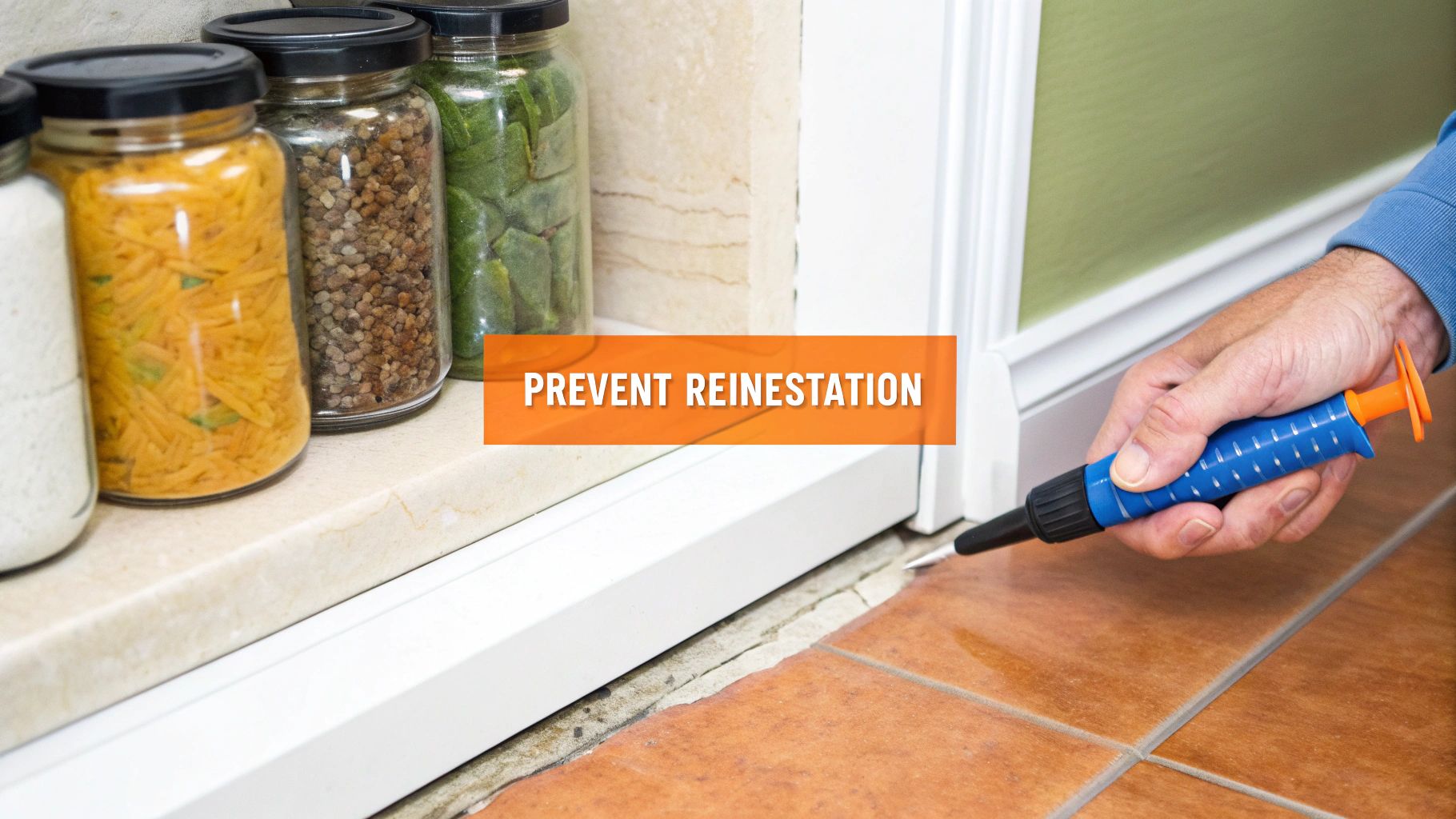
Think a spotless home is a pest-proof home? Think again. Pests are opportunists, and they don’t need a huge mess to decide to move in. Truly effective do it yourself home insect control is all about shifting from a reactive mindset to a proactive one—making your home completely uninviting from the get-go.
Dealing with an active infestation is just one part of the job. The real win is making sure they never get a chance to come back. This means you need to stop thinking like you're just cleaning up and start thinking like a security guard for your home's perimeter.
Sealing Off All Entry Points
Insects rarely use the front door. That tiny crack in your foundation is basically a four-lane highway for an ant colony. The small gap under your garage door? It's a welcome mat for spiders and crickets. Your first task is to walk the outside of your home and hunt down these vulnerabilities.
Start with the most obvious spots. Grab a high-quality silicone caulk and get to work filling any cracks or gaps around pipes, vents, and utility lines where they enter your house. Homeowners miss these spots all the time. If you can see daylight peeking under your exterior doors, it’s time to install new door sweeps.
From there, dig into the less obvious entry points:
- Window and Door Screens: A tiny tear is all a mosquito or fly needs. Check every single one for even the smallest holes.
- Foundation Vents: Make sure the screens on your crawl space and attic vents are secure and completely intact.
- Weep Holes: Those little drainage holes in brick can be a secret entrance for pests. You can find special covers designed to let water out while keeping bugs from crawling in.
Remember, an insect can squeeze through a gap that looks impossibly small. Sealing these entryways is the single most powerful preventative step you can take.
Eliminating Food and Water Sources
Pests invade your home for the same reasons you live there: food, water, and shelter. Take away their access to these necessities, and they’ll have zero reason to stick around. This is the bedrock of long-term do it yourself home insect control.
A few crumbs on the counter can be a full-blown banquet for an ant colony. This means proper food storage is non-negotiable. Get everything out of its original cardboard box—cereal, flour, sugar—and into airtight containers. Don't forget the pet food, either. Keep it in a sealed bin and clean up any spills immediately.
Water is just as critical. A slow drip from a bathroom faucet or a damp spot under the kitchen sink is all it takes for a cockroach colony to thrive.
- Fix Leaks Promptly: Make it a habit to check under every sink and around your toilets for any hint of moisture.
- Manage Condensation: Insulate pipes to stop them from "sweating" and creating a persistent water source.
- Empty Standing Water: Don’t leave pet water bowls full overnight, and always wipe your sinks dry before bed.
If you've sealed every crack and locked down all food sources but still see bugs, you might need an expert eye. A pro can often spot hidden issues you've missed. For a quick assessment, call +1 855 224 3071 and get connected with a local specialist.
Maintaining Your Yard and Exterior
Your prevention strategy has to extend beyond your walls. The area immediately surrounding your house is a staging ground for pests looking for a way inside. An overgrown, cluttered yard is the perfect base camp for them.
You need to create a clear, bug-free zone of about 18-24 inches around your entire foundation. This means keeping mulch, firewood stacks, and dense bushes away from the house. Doing this eliminates the damp, sheltered environment that pests absolutely love and makes your home a much tougher target.
Pay attention to your outdoor lighting, too. Those bright white bulbs attract swarms of flying insects at night. Simply switching to yellow "bug light" bulbs can make a massive difference, since most insects can't see yellow light well. Taking these easy steps outside will make all your indoor do it yourself home insect control efforts that much more effective. If you’re ever unsure what to do next, a quick call to +1 855 224 3071 can get you the advice you need.
Knowing When to Call a Professional
Ever feel like a do it yourself home insect control problem is a personal failure? Don't. Knowing when to tag in an expert is one of the smartest moves a homeowner can make. It’s not about giving up; it’s about making a strategic call to protect your property and family when the stakes get too high.
Calling a professional isn't admitting defeat. It's the most responsible thing you can do when you're outmatched. Your peace of mind is worth a lot more than stubborn DIY pride.
Red Flags That Demand Professional Help
Some pest problems are just too big, too dangerous, or too hidden for store-bought solutions. If you spot any of these warning signs, it's time to pick up the phone.
- Pests That Just Keep Coming Back: You’ve done everything right—identified the bug, used the recommended treatments, sealed up cracks—but they’re still here. This is a classic sign of a hidden, large-scale nest or a tricky entry point that only a trained eye can find.
- Large-Scale Infestations: Seeing a couple of ants is an annoyance. Seeing hundreds swarming your counters every morning is a five-alarm fire. Widespread infestations mean the colony is well-established, and DIY sprays just won't cut it.
- Signs of Structural Damage: Pests like termites and carpenter ants aren’t just gross; they actively destroy your home. If you notice mud tubes on your foundation, weird piles of wood shavings, or floors that are suddenly sagging, you need an emergency inspection, period.
- Pests That Pose Health Risks: A wasp nest hanging over your front door, cockroaches triggering asthma, or finding venomous spiders are not situations for trial and error. These threats require immediate, professional handling to keep everyone safe.
Calling a professional is often the cheapest option in the long run. The cost of one expert treatment is nothing compared to the price of repairing termite damage or wasting money on DIY products that don't work.
If any of this sounds familiar, don't let it get worse. Get immediate help from a vetted specialist by calling +1 855 224 3071.
High-Stakes Pests You Shouldn't Handle Alone
While you can tackle many common household bugs yourself, a few pests are in a completely different league. Their ability to hide, multiply, and cause serious harm makes them terrible candidates for a do it yourself home insect control plan.
Termites: These pests are famous for a reason. In the U.S. alone, pests like termites cause over USD 5 billion in property damage every single year. A DIY attempt often just makes the colony move to another part of your house to continue eating away at your investment, completely unseen. That massive financial toll shows why professional intervention is essential; you can discover more insights about pest control industry trends on insights.workwave.com.
Bed Bugs: Bed bugs are the escape artists of the pest world. They can survive for months without a meal, hide in impossibly small cracks, and have built-up resistance to many pesticides. One failed DIY treatment can easily spread them from one room to your entire home, turning a manageable problem into a nightmare. If you even suspect bed bugs, calling an expert at +1 855 224 3071 is the only reliable way to solve it.
When you're facing a pest problem that feels overwhelming or dangerous, don't hesitate. Pest Control Service Finder connects you with local, licensed exterminators who can provide a fast, safe, and effective solution. Reclaim your home and your peace of mind by visiting https://pestcontrol-service-finder.com or calling our 24/7 hotline.
